#anglo Saxon England
Text
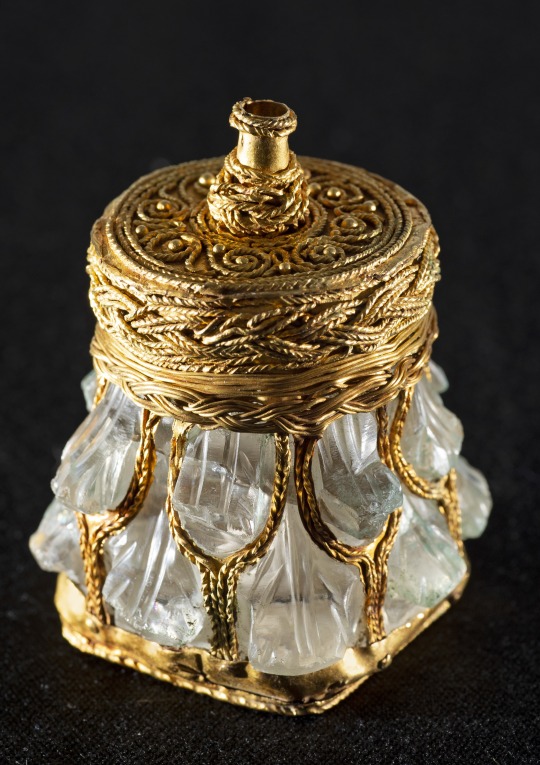
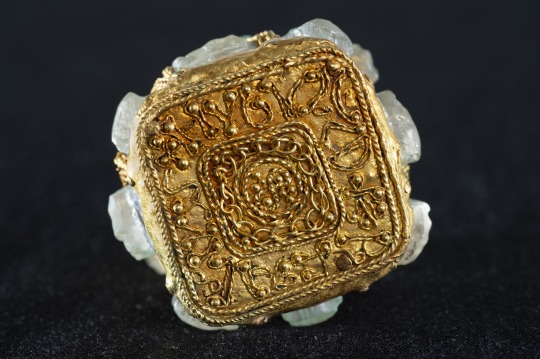
Hey Everyone! Look at this Gold and Rock Crystal Bottle from the Galloway Hoard!
In September of 2014 an avid metal detectorist named Derek Mclennan discovered one of the grandest historical finds in Scottish archaeological history. While searching on church lands near Balmaghie, Mclennan uncovered the Galloway Hoard, a viking age treasure hoard consisting of over 100 objects dating to around 900 AD. While the hoard has some gold objects, most are silver including pieces of jewelry, hack silver, and silver ingots.

Among the objects, the most incredible is a rock crystal bottle that is decorated with gold. The bottle was found inside of a silk pouch, the silk coming from either Byzantium or Asia. The crystal jar itself is not from the middle ages but is Roman and dates to the 4th century. Later in the early middle ages the jar was decorated in gold filigree, at the behest of Bishop Hyguald according to an inscription on the gold work. While the identity of "Bishop Hyguald" is unknown, it is thought that he mostly likely came from Northumbria, an Anglo-Saxon kingdom in northern England. Northumbria would be conquered and occupied by Danish Vikings in the 9th century, which explains how the bottle became a part of the Galloway Hoard.
Today, the bottle along with the rest of the Galloway Hoard is housed at the National Museum of Scotland
#history#antiquities#art#middle ages#medieval art#vikings#anglo saxon england#scotland#scottish history
658 notes
·
View notes
Text
"That Æthelswith was the bestower of such gifts is consistent with the other things we know about her. In 868 she witnessed a West-Saxon charter, in which she made a grant of fifteen hides of her own land in Berkshire. She also witnessed all of her husband King Burgred’s charters. Though we only see glimpses of her influence, Æthelswith, like other Mercian queens before her, was a politician.
In 874, twenty one years after Æthelswith married Burgred, the royal couple were forced out of their kingdom by an encroaching Viking army. They fled together to safety in Rome. While Burgred died soon after they arrived, Æthelswith outlived him for another decade, which she spent in Italy.
Queen Æthelswith passed away in 888 in Pavia, and was laid to rest there. She may have been undertaking a pilgrimage when she died. Her body and the ring that she once bestowed were both buried underground a thousand miles apart. And they say medieval women didn’t travel…"
#Æthelswith#history#women in history#women's history#9th century#english history#queens#leaders#english queens#anglo saxon history#anglo saxon england#medieval women#medieval history#middle ages#medieval#archeology
249 notes
·
View notes
Text
17 notes
·
View notes
Text
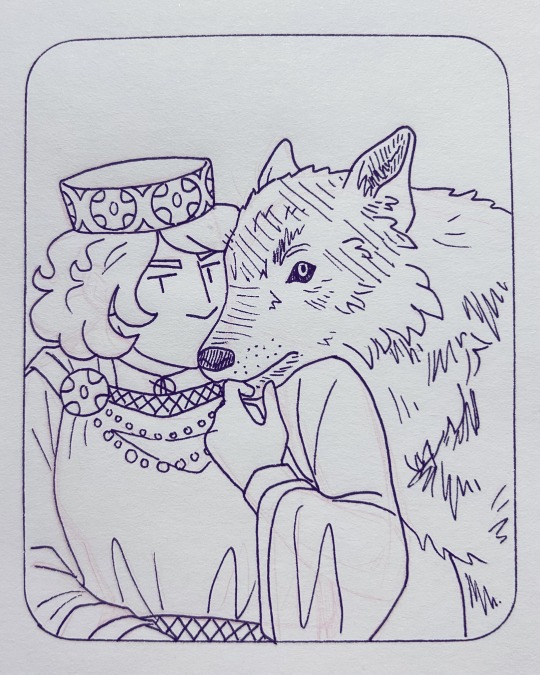
Day 28: Wolf - Aelfthryth, third wife of Edgar the Peaceful
#jenstober23#queen aelfthryth#edgar the peaceful#aethelred the unready#anglo saxon england#medieval england#saxon tag#wolf#10th century#history art#traditional art#inktober#inktober 2023#drawtober#drawtober 2023#artober#artober 2023#witchtober#witchtober 2023#day 28
8 notes
·
View notes
Text

The Boyhood of Alfred the Great by Edmund Blair Leighton
#alfred the great#osburh#osburga#mother#boyhood#art#edmund blair leighton#edmund leighton#wessex#anglo saxon#anglo saxons#history#english#england#middle ages#medieval#osburga oslacsdotter#education#christian#christianity#mediaeval#royal#royalty#royals#house of wessex
118 notes
·
View notes
Text
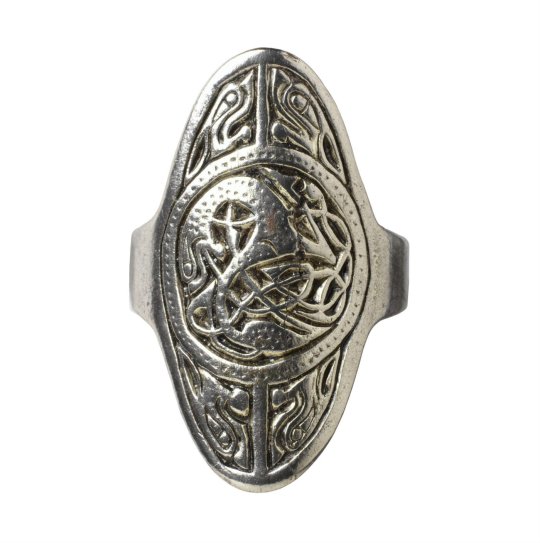
Ring
Anglo-Saxon, 775-850 CE
The inlaid gold and filigree jewellery of the seventh century was largely replaced in the early eighth century by silver work as a consequence of the increasing scarcity of gold. The focus on silver gave rise to new decorative schemes: the material lent itself to different techniques such as repoussé, chip carving and the openwork seen on the present ring. The growth in popularity of these decorative techniques was accompanied by a distinctive development of zoomorphic style, characterized by lively beasts, interlaced meshes and speckled surfaces, all of which are present in the central roundel of this ring.
Examples of high quality silver jewellery of the period from which the present ring dates are relatively rare. The abandonment of the pagan burial practice of interring grave goods with the deceased has led to the survival of fewer pieces. The majority of those that have been found were preserved as a result of their casual loss and the provenance of this ring, found in the Thames, suggests that it too is an example of accidental misplacement.
127 notes
·
View notes
Text
A Pre-Christian cultic temple unearthed in Suffolk! Delve into the latest excavation revealing a potent symbol of Anglo-Saxon paganism and royal power near the legendary Sutton Hoo.
71 notes
·
View notes
Text
Honestly I hope to God Arthur went absolutely apeshit on some puritan parliamentarians the 1640s, because if I were him and these miserable sods kept desecrating the graves of my oldest and most precious kings and queens I think I could commit war crimes too.


#i hope he bit cromwell's dick off is what i'm saying#hetalia#op#historical hetalia#hws england#headcanon#what the heck did the anglo saxon kings do to you you know?
106 notes
·
View notes
Text
for any interested parties, here is our history Byler timeline as of now (extremely disproportionate version):
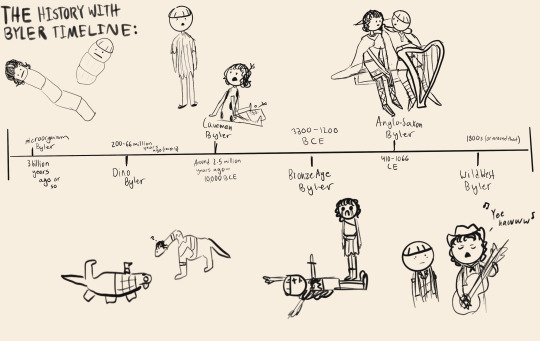
We must expand. If you have any history Byler you might want to see, don’t be scared to suggest it in my asks!
#byler#stranger things#byler fanart#will byers#dino Byler#history with byler#caveman byler#bronze age Byler#anglo saxon byler#wild west Byler#I love them all so much#microorganism byler#my favorites ever#and you guys are so creative too#Like who suggested Anglo Saxon England???#Beautiful
119 notes
·
View notes
Text

Venerable Bede's 7th century manuscript 'On the Reckoning of Time'
#De Temporum Rationae#Venerable Bede#British Library#UK#'On the Reckoning of Time'#Latin#Middle Ages#7th century#vellum#Anglo-Saxon England#Early Britain#church history
86 notes
·
View notes
Photo




03.20.2023 | Grantebridgescire
Captured on PS5.
#discovery tour viking age#ac discovery tour#grantebridgescire anglo saxon england#assassin's creed valhalla#ac valhalla#assassin's creed#ac photo mode#virtual photography#ps5 share#playstation 5#ubisoft montreal#ubisoft
86 notes
·
View notes
Text

On 12 July 927 King Constantín mac Áeda, King Hywel Dda , Ealdred of Bamburgh, and King Owain ap Dyfnwal gathered at Eamont, near Penrith, to accept Æthelstan as their overlord.
Æthelstan was king of the Anglo Saxons and later England, regarded by many as their first King, Constantín mac Áeda, giving him his old Gaelic name, was King of Alba, mostly covering lands around the Tay down to the Forth, King Hywel Dda, it won't surprise you was ruler of Wales, Ealdred of Bamburgh, King of Northumberland and Owain ap Dyfnwal ruled Strathclyde, which included parts of modern day Cumbria.
After defeating the Norsemen at York Æthelstan started to stamp his authority in the North and according to the ‘Annals of Ulster’ in 927 AD Constantine and Owain had met with Æthelstan, on what was probably the Northumbria/Strathclyde border, where:
“... they surrendered themselves and their kingdoms to the sovereign of England. Out of regard to this treaty, the king himself stood as sponsor for the son of Constantine, who was ordered to be baptized at the sacred font.”
The ‘Anglo-Saxon Chronicle’ also records the meeting its list of attendees differed and it's a wee bit more dramatic, so I'll classify it as the tabloid of the day!! “In this year [927] fiery beams of light appeared in the north part of the sky. And Sihtric died; and King Athelstan succeeded to the kingdom of the Northumbrians, and he subjugated all the kings that were in this island: first, Hywel king of the West Welsh, and Constantine king of the Scots, and Owain king of Gwent, and Ealdred son of Eadwulf from Bamburgh:+ and with pledge and with oaths they confirmed peace, in the place called Eamont, on the 4th of the Ides of July [12th July], and renounced every kind of idolatry; and after that departed in peace.”
It led to six years of peace between the Northern Kings and the new King of England, by 934 things had taken a turn as “In this year King Athelstan went into Scotland, with both a land-force and a ship-force, and ravaged a great part of it.”
Other sources tell that Constantine's son was taken to England as a hostage to keep the peace.
There is loads more info on how things developed in the tenth century and beyond here http://www.dot-domesday.me.uk/athelstan.htm
The pic shows how the British Isles looked back then.
63 notes
·
View notes
Text
"A tyrant after the manner of her father."
As one of the children of Offa of Mercia and his celebrated queen Cynethryth, Eadburh inherited an elevated view of queenship. By the time of Eadburh’s marriage, the office of queen was developing into something more akin to the position recognised in the 973 Regularis Concordia, which recognised queens with their own anointing ceremony and made them, like the king, protectors of monastic houses. The queenship Eadburh had modelled to her in the person of her mother was influential, involved in the everyday running of the court, and possessed considerable independent power.
Eadburh’s marriage to Beorhtric does not usually crop up in discussions of conventional peaceweaving marriages because she is most usually considered in terms of political biases reacting poorly against women: her story is recorded in a history written by the victors, in which she is both nemesis and victim. Nevertheless, when considered closely, her marriage does appear to fit the characteristics of a peaceweaving marriage. Her union with Beorhtric seems to have been intended to draw the two peoples more closely together, especially considering the adverse history between the two kingdoms.
The peaceweaving aspect of the marriage becomes more apparent when the considering the relationship between Offa and his son-in-law. Beorhtric’s succession to the West Saxon throne seems to have ushered in a spirit of cooperation between the two traditionally rival kingdoms. In 789, Offa banished Ecgberht, later king of Wessex, and the grandfather of King Alfred. Although he clearly also benefited from the removal of a rival for the throne, Beorhtric enforced this exile as well. There are no formal documents outlining what the relationship between Beorhtric and Offa constituted, although S.E. Kelly detects ‘some hint of subservience … betrayed in the three surviving charters of Beorhtric, where the royal styles are curiously humble and tentative’. Asser’s text similarly confirms the close political relationship between Offa and Beorhtric – which, according to traditions handed down by Ecgberht’s line, is attributed to Eadburh. Asser writes how Offa made the match: ‘Beorhtric, king of the West Saxons, received in marriage [Offa’s] daughter, called Eadburh. As soon as she had won the king’s friendship, and power throughout almost the entire kingdom, she began to behave like a tyrant after the manner of her father’ [...].
The account given by Alfred to Asser is designed to discredit Eadburh and explain why the office of queen had been abandoned in Wessex, and does so by undermining the wife of a dynastic rival. There is considerable bias in seeking to discredit both Beorhtric and Eadburh, but the account fails to conceal that Eadburh probably was, at least at first, a rather effective queen. Before her marriage, she had witnessed charters as the daughter of the king and queen of Mercia. To be able to muster power of the sort attributed to her suggests that she had good relationships: she won the friendship of the king, her most important relationship. For Eadburh to have power throughout the kingdom, she must have maintained a good relationship with her father and brother to protect her, but possibly also forged new relationships by a mixture of patronage and promoting their interests at court. These are skills she may have learned from her mother Cynethryth [.] [However, Cynethryth] had the distinct advantage of having a Mercian background herself, and as a result did not have to negotiate the difficult position of mediating between her natal family and identity and her status as queen of a different kingdom in quite the same way.
The West Saxon traditions handed on by Ecgberht’s descendants clearly blame Offa and his tyrannical ways for influencing his daughter’s practice of queenship [and indicates that she might have acted as ‘an active representative of Mercian interests at the West Saxon court', as Barbara York points out]. On closer consideration, Eadburh is far more likely to have emulated her mother’s practice. Unusually, Asser and Alfred ascribe Eadburh’s monstrous behaviour as deriving from her father’s model of kingship. Other texts tend to emphasise feminine monstrous and overly assertive behaviour, especially where Offa’s queen Cynethryth is concerned.
Misogynistic leanings influenced the way that both Cynethryth and her daughter Eadburh are portrayed. Traditions at St Albans blamed Cynethryth for the murder of Æthelberht, drawing on a biblical tradition associated with John the Baptist. It is hardly surprising, therefore, when Eadburh herself was blamed for the deaths of unnamed nobles as well as Beorhtric and a well-loved West Saxon noble, probably Worr, as recorded in the Anglo-Saxon Chronicle entry for 800 [...].
The accounts of Eadburh following the death of Beorhtric come solely from the West Saxon dynasty hostile to her husband and father, but other independent sources may corroborate certain details. The account of her behaviour at Charlemagne’s court in Asser’s text may contain some kernels of truth, but seems to be a wild attempt to further discredit Eadburh and her Mercian heritage. After her husband’s death, Eadburh fled with a quantity of treasure, which may have either been her own treasure, or the royal treasury. The West Saxon tradition states that Eadburh later sought refuge in Francia, where she came to Charlemagne’s court and was offered a choice of husbands – either Charlemagne, or one of his sons. In the story, Eadburh selfishly chose the younger option, and as punishment for her selfish choice, was given neither, but instead received a nunnery (V. Alfredi, c. 15). There is a kernel of truth at the core of this tradition: Offa and Charlemagne had been in negotiations for one of the Mercian princesses to wed to one of the Frankish king’s sons. The talks broke down, reportedly, because Offa insisted on a reciprocal Frankish princess bride for his son Ecgfrith. The attribution of Beorhtric’s death to Eadburh is difficult to either confirm or deny: Ealhflæd’s involvement in Peada’s death demonstrates that a queen could be involved in her husband’s death, and poison was a favoured accusation to use against unpopular queens from antiquity into the modern age*. The account contains yet one more kernel of truth: Eadburh’s geographic peregrinations. Asser’s account in Chapter 15 of his Life of Alfred records that Eadburh spent some time as an abbess in a Frankish abbey before being ejected for having an affair with one of her countrymen, and ended her life begging in Pavia. Janet Nelson’s analysis of this information points out that there are some reasons to believe Asser’s version: Frankish abbesses tended to be royal appointments, and an entry in the Reicheneau Liber Vitae has an ‘Eadburg’ who was abbess of a convent in Lombardy. Pavia was on the traditional pilgrimage route to Rome, which was popular with early English pilgrims. Eadburh’s continental peregrinations also fit with the developments in Mercia following her marriage. In 796, Offa died, leaving the throne to his son and heir Ecgfrith. Unfortunately, Ecgfrith passed away within months, ending the dynasty. With the passage of the throne to a relatively distant relative in Coenwulf, there was little to offer Eadburh on her return. Like Osthryth, the collapse of her family caused by the deaths of her nearest male relatives weakened her options to a delicate situation, thereby obliging her to seek assistance abroad.
Eadburh is vilified in the West Saxon sources as a wicked queen whose appetite for fame and power were her undoing. Because Offa helped drive Ecgberht from Wessex and into exile, the royal line descended from Ecgberht largely effaced the office of queen, recently expanded and abused by Offa’s daughter, from the way they ruled. Asser comments how the West Saxon kings following Ecgberht did not follow the custom of nominating the king’s wife as a queen as a response to Eadburh’s wickedness.He remarks on ‘the (wrongful) custom of that people … [f]or the West Saxons did not allow the queen to sit beside the king, nor indeed did they allow her to be called “queen”, but rather “king’s wife”.
Stefany Wragg, "Early English Queens, 650-850: Speculum Reginae"
*The Anglo-Saxon Chronicle, when writing about Beorhtric's death in 802, makes no mention of any alleged treachery and/or poison on Eadburh's part. This is in sharp contrast to the way chronicles did almost unanimously emphasize the role of another queen - Ealhflæd - in the murder of her husband. It's possible, though unlikely, that Beorhtric may have simply died naturally. Alternatively, considering the death of his Mercian protector Offa just a few years before his death, considering that he was succeeded immediately by Ecgberht, an enemy he had exiled from the kingdom, and considering how there was apparently a battle between a Mercian and Wiltshire ealdorman on the same day Ecgberht ascended the throne (resulting in Mercian defeat), it's quite possible that the cause for Beorhtric's downfall was dynastic, and more akin to a traditional defeat or deposition, than any conveniently miscalculated treachery by his wife. In this context, Eadburh's sudden flight abroad with a quantity of treasure after his death resembles that of other queens who witnessed the downfall of their dynasties and had to flee to protect themselves.
#historicwomendaily#she and Seaxburh are the most interesting Anglo-Saxon queens to me for sure (though Ethelburh Aethelflaed and Edith of Wessex come close)#I want to do a separate post 'tracing' Eadburh and what we know of her + my own interpretation someday#but until then....here's this post#anglo-saxons#anglo-saxon england#eadburh#eadburh of wessex#english history#my post#queue
14 notes
·
View notes
Text
94 notes
·
View notes
Text

Day 17: Fall - Eadyth of Mercia
I’m almost caught up!!
#jenstober23#eadyth of mercia#edith of mercia#medieval england#anglo saxon england#11th century#history art#traditional art#trans pride#twttwba#fall#halloween#saxon tag#inktober#inktober 2023#drawtober#drawtober 2023#artober#artober 2023#witchtober#witchtober 2023#day 17
5 notes
·
View notes
Text


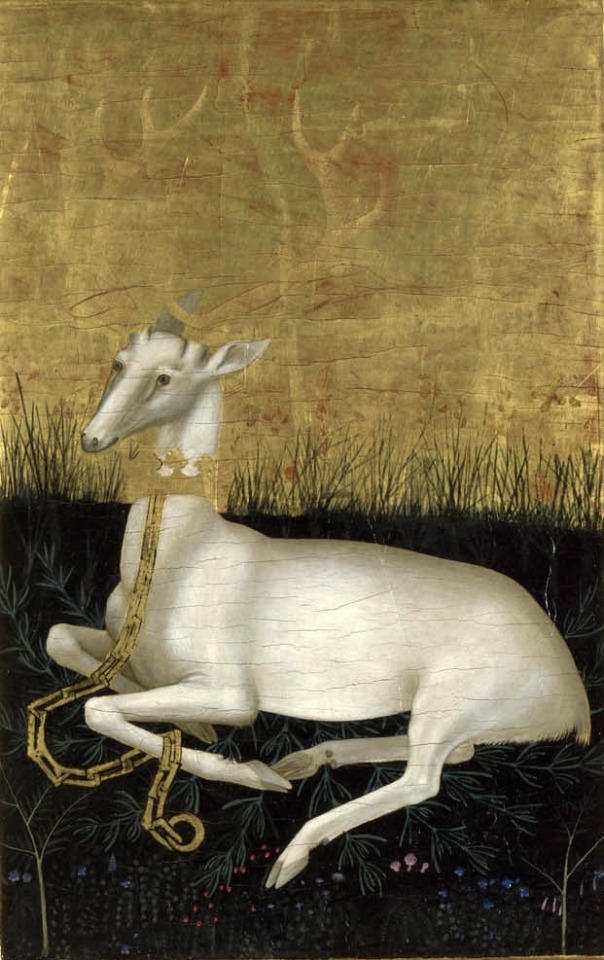
The Wilton Diptych (1395–1399) — Coat of arms of Richard II (Arms of England of 1340 impaled with the mythical arms of Edward the Confessor), with Richard II's white hart badge.
#medieval#middle ages#mediaeval#art#england#english#altarpiece#richard ii of england#edward the confessor#coat of arms#heraldry#white hart#hart#stag#history#anglo saxon#anglo saxons#king#saint#christianity#christian#religious art#religion
119 notes
·
View notes